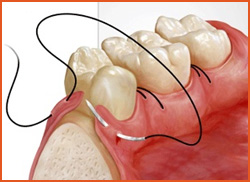Gum disease or Periodontal disease is often silent, meaning symptoms may not appear until an advanced stage of the disease. However, warning signs of periodontal disease include the following:
- Red, swollen or tender gums or other pain in your mouth.
- Bleeding while brushing, flossing, or eating hard food.
- Gums that are receding or pulling away from the teeth, causing the teeth to look
longer than before.
- Loose or separating teeth.
- Pus between your gums and teeth.
- Sores in your mouth.
- Persistent bad breath.
- A change in the way your teeth fit together when you bite.
- A change in the fit of partial dentures.
Scaling/cleaning of teeth is a procedure by which the dentist through an ultrasonic scaler removes the plaque, tartar & food particles from the tooth surface and surface of restorations. Tartar/ Calculus appear as yellow /brown/blackish hard deposits between gums and teeth.
Excessive deposition of tartar over a period of time leads to mobility of teeth and unhealthy gums. External stains on the teeth which cannot be removed by simple brushing can be removed by scaling and polishing. External stains on the teeth are caused by smoking, tobacco, tea & coffee intake etc. Sometimes even if a person does not have these habits still stains are observed. That is because of few chromogenic bacteria present in the saliva which causes these stains.
Scaling is done by ultra sonic machine which does not cause any harm or scratches on the natural tooth structure. No local anesthesia is given for this procedure as this is virtually painless procedure.
- Scaling is a part of oral prophylaxis which needs to be done every six months.
- Is done for patients having bleeding gums, foul smell from mouth, stickiness in mouth, mobility of teeth.
- Teeth become weaker.
Mobility of teeth post scaling is a myth as teeth can only get better and healthier after scaling. Presence of tartar holds the shaky teeth intact psychologically, but actually it is causing a negative impact on the natural attachment of gums and teeth.
- Gaps are increased than before.
In some cases there are gaps between teeth which gets covered by tooth colored tartar. On removal of this tartar the patient feels the gap has occurred due to cleaning of teeth which is wrong.
- Sensitivity appeared which was not there prior to the scaling procedure
As the tartar is removed the concealed part of the teeth is exposed to the oral environment thereby causing mild to moderate sensitivity to the teeth which is transient. This sensitivity vanishes in a day or two. Most of the patients do not even experience this sensitivity.
Gingival flap surgery is a type of gum procedure. The gums are separated from the teeth and folded back temporarily. This allows a dentist to reach the root of the tooth and the bone. During this time, the dentist can clean the deposited tartar and hard set calculus.
- Gingival flap surgery is used to treat gum disease (periodontitis/pyorroea).
- It may be recommended for people with moderate or advanced periodontitis.
- Usually, a treatment that doesn't involve surgery is done first. This is called scaling and root planning. If this treatment does not eliminate the gum infection, gingival flap surgery is indicated.
- Flap surgery is done to treat gum enlargements.
- Bone grafting and guided tissue regeneration are done along with flap surgery procedure, if required.
- First, a local anesthesia is given to numb the area.
- Then the periodontist will use a scalpel to separate the gums from the teeth.
- They will be lifted or folded back in the form of a flap. This gives the periodontist direct access to the roots and bone supporting the teeth.
- Inflamed tissue will be removed from between the teeth and from any defects in the bone.
- The periodontist will then do a procedure called scaling and root planning to clean plaque and tartar.
- If you have bone defects, your periodontist may eliminate them. This procedure is called osseous recontouring. It smoothes the edges of the bone using files or rotating burs.
- After these procedures are completed, the gums will be placed back against the teeth and stitched (sutured) in place.
- Some periodontists use stitches that dissolve on their own. Others use stitches that have to be removed a week to 10 days after the surgery.
- Your periodontist also may cover the surgical site with a bandage known as a periodontal pack or dressing. If bone is deficient, then the periodontist may also put some bone grafting material there.
- There can be mild pain, oozing of blood and /or mild swelling.
- After flap surgery, there can be mild gingival recession.
- Temporary sensitivity to hot and cold can be encountered.
Bone grafting is a medical procedure wherein a part of the missing bone is replaced by another bone or material known as bone graft. Through this surgical procedure, the graft not only replaces the missing portion of the bone, but also helps the regrowth of the bone. Over a period of few months, the existing bone and the grafts fuse.
Bone grafts are generally used when bone is missing which can happen mainly due to periodontal disease (pocket formation), trauma, accident, tumor removal or it maybe congenital in nature. Bone grafts are also used with dental Implants
- A dental bone grafting procedure is carried out under local anesthesia. With a routine flap surgical procedure, bone grafting is done at sites where it is required to produce new bone. It is a relatively painless procedure with minimum postoperative complications.
- These bone grafts, over a period of time form new bone and aid in the correction of a periodontal defect or healing of a periodontal pocket. New bone formation also stabilizes the Implants or creates adequate bone for the placement of Dental Implants.

